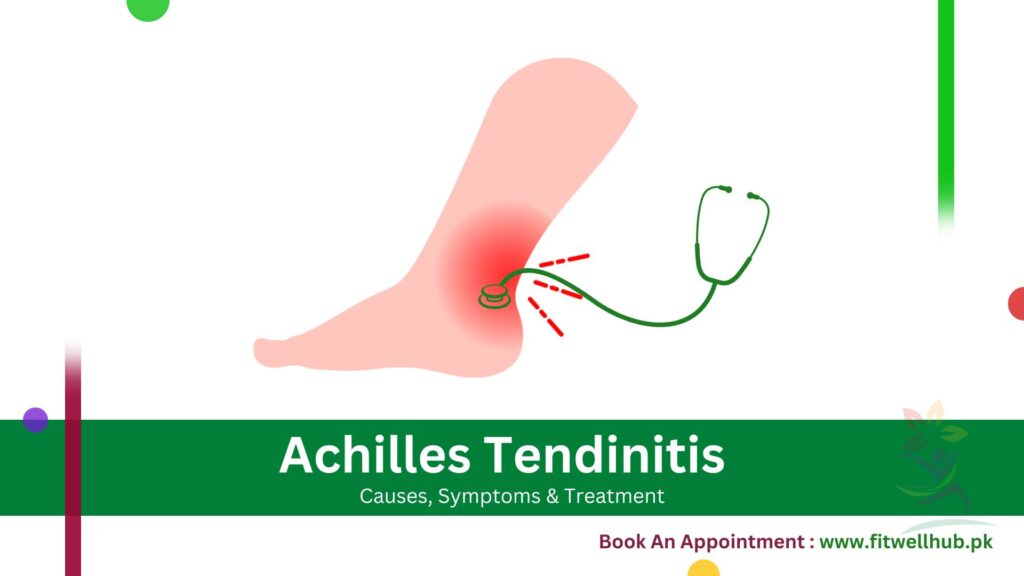Achilles tendonitis is a prevalent overuse injury also referred to as Achilles tendinopathy in which the Achilles tendon, the largest and strongest tendon in the human body, is frequently injured. It is a disease that can make a very dedicated athlete incompetent.
Quick Links
ToggleThis tendon joins the heel bone to the calf muscles which play an important role in physical activities such as jumping, pushing off the ground, and running. When inflammation and irritation occur in this tendon, it can cause major discomfort. Due to Achilles tendonitis, our ability to do everyday tasks and participation in sports will be disturbed.
Understanding the Achilles Tendon pain
Significant knowledge of the Achilles tendon’s function and analysis is essential before discussing Achilles tendonitis specifics. The Achilles tendon’s elastic and strong structure plays an important role in our capability to walk, run, and jump.
The Achilles tendon is a fibrous and thick band that joins the heel bone named calcaneus with the two main calf muscles named soleus and gastrocnemius. The basic function is to transfer the strong forces produced by these two calf muscles to the foot. These forces help us in pushing off the ground while doing different tasks.
Despite its strength, the Achilles tendon is more prone to injury, especially in those who engage in high-impact, repetitive activities. It is important to understand its functions and structure to recognize the common risk factors and implementation of preventive measures.
Symptoms of Achilles Tendinitis
The signs and symptoms of Achilles tendinitis must be known for its proper diagnosis and treatment. Here are some common signs:
- Pain and Stiffness: The most obvious symptom is a dull ache, soreness, or stiffness along the Achilles tendon, especially in the morning or after a period of rest.
- Swelling and Warmth: Inflammation in the tendon can cause visible swelling of this area as well as warmth.
- Tenderness: Applying pressure to the Achilles tendon may also result in tenderness or pain.
- Limited Range of Motion: This condition can make it difficult to bend or point toes due to limited range of motion.
- Crepitus: There could be situations whereby you sense that there is a crackling or grinding sensation while moving the affected part.
When to Seek Medical Help
While mild cases of Achilles tendinitis may get better with self-care, some situations require one to see a doctor:
Severe Pain or Swelling
In case you have severe pain, noticeable swelling, or cannot walk properly, then it is nice for you to find the help of a medical professional as soon as possible.
Persistent Symptoms
If your symptoms continue for more than one week after taking rest & practicing self-care measures, seek a medical checkup. They could be an indication of a more serious health issue.
Limited Range of Motion
When there is a significant limitation in your ankle’s range of motion or if flexing/pointing your foot is difficult then it may indicate a more serious injury that requires medical attention.
Sudden Onset of Symptoms
The sudden development of symptoms connected with Achilles tendonitis or when those symptoms are accompanied by popping or snapping. It sounds can be indicative of partial or complete ruptures, which should be treated straight away by doctors.
If you need consultation for your symptoms, Fitwell Hub offers expert medical consultations.
Causes of Achilles Tendinitis
Various factors may cause Achilles tendinitis such as improper training or workout techniques, overuse, external forces, and biomedical imbalances. Some common causes are given below:
1- Overuse: Continuous stress on the Achilles tendinitis during activities such as jumping and running. It sudden spikes in training intensity may result in inflammation and small tears in this tendon.
2- Age and Degeneration: As we get older, the elasticity and flow of blood decrease, resulting in more chances of injury and degeneration of the Achilles tendon.
3- Biomechanical Imbalances: Several biomechanical imbalances, such as high arches, muscle tightness in the Achilles tendon, and overpronation (excessive inward rolling of the foot), can cause Achilles tendinitis.
4- Side Effects of Medication: Achilles tendon injury risks may increase with the use of medicines such as corticosteroids and fluoroquinolone antibiotics.
5- Bone Spurs: When bony growths on the heel bone (calcaneus) rub against the Achilles tendon then inflammation and irritation are produced in it. Knowing the potential causes is important to identify and address the underlying reasons for your Achilles tendonitis.
Risk Factors for Achilles Tendinitis
Though anyone can have Achilles tendinitis, some factors might increase someone’s chances of having it. Knowing these risk elements will enable us to take precautionary measures and modify our activities or training accordingly:
- Age: The Achilles tendon becomes more vulnerable to degeneration and injury as we grow.
- Obesity: Being overweight adds more pressure on the Achilles tendon hence increasing chances of injury.
- Tight Calf Muscles: When there is stiffness in these muscles, it will put a lot of stress on the Achilles tendon causing swelling and injury.
- Sudden Increase in Activity: Without proper conditioning, abruptly increased intensity, duration, or frequency of activities may overwhelm the Achilles tendon.
- Improper Footwear: Wearing unsupportive shoes without cushioning can contribute to strain on the Achilles tendon resulting in an injury.
- Previous Injuries: Individuals who have experienced problems with their lower limbs, especially Achilles tendons are likely to suffer from them again.
- Certain Medical Conditions: Individuals having medical conditions including rheumatoid arthritis, psoriatic arthritis, and diabetes are at higher risk of having Achilles tendonitis.
Prevention and Management of Achilles Tendinitis
As far as Achilles tendinitis is concerned, prevention is better than cure. Here are some practical tips for preventing this injury:
1- Proper Warm-up and Cool-down
Before and after engaging in either exercise or sports, ensure a complete warm-up and cool-down routine to ease the strain on muscles and tendons.
2- Stretching and Flexibility Exercises
When doing your regular exercises, remember to include flexibility exercises that concentrate on the calf muscles and the Achilles tendon to maintain its range of motion with reduced tension.
3- Gradual Progression
In case you are starting a new workout program or increasing its intensity, you must progress slowly so as not to stress your Achilles tendon.
4- Proper Footwear
Put on good quality shoes which are well cushioned providing adequate support and stability for your chosen activity. Always buy a new pair of shoes soon when they start wearing out.
5- Epsom Salt Baths
Take warm baths using Epsom salts to reduce inflammation along with relieving the affected tendons’ and muscles’ stiffness.
Treatment Options for Achilles Tendinitis
The choice of an effective treatment option will be dependent on the severity of the disease and the healthcare provider’s recommendations.
Ice and Compression
Applying compression bandages and ice packs to the affected part results in a reduction of inflammation as well as relieving pain.
Medication
Non-prescription anti-inflammatory drugs such as ibuprofen and naproxen can bring down swelling and ease pain. Your doctor can prescribe stronger anti-inflammatory drugs or administer corticosteroid injections on certain occasions.
Extracorporeal Shockwave Therapy (ESWT)
This treatment does not involve any incisions but uses sound waves with high energy levels to accelerate healing within the Achilles tendon. ESWT may be another option for long-standing cases of Achilles tendinitis.
Platelet-Rich Plasma (PRP) Injections
PRP therapy requires injecting concentrated platelets from the patient’s blood into damaged tissues to facilitate tissue regeneration and healing.
Surgery
Where conservative methods fail to cure severe Achilles tendinitis that continues for long periods, surgery might become necessary. This may include removing diseased tendon sections, mending tears, and correcting bone spurs and other structural problems.
GET IN TOUCH
Frequently Ask Questions (FAQs)
Healing from Achilles tendonitis depends on your severity. Proper rest, applying ice, compression to the affected area, and taking prescribed medication can treat this.
Achilles tendonitis can be cured quickly by proper resting and medication prescribed by healthcare professionals.
Various factors may cause Achilles tendinitis such as improper training or workout techniques, external forces, and biomedical imbalances.
The Achilles tendon, a thick, fibrous band, connects the two main calf muscles, the gastrocnemius and soleus, to the heel bone, the calcaneus.
Running, jumping, and sudden spikes in training intensity can cause continuous stress on the Achilles tendon, resulting in microtears and inflammation within the tendon.











